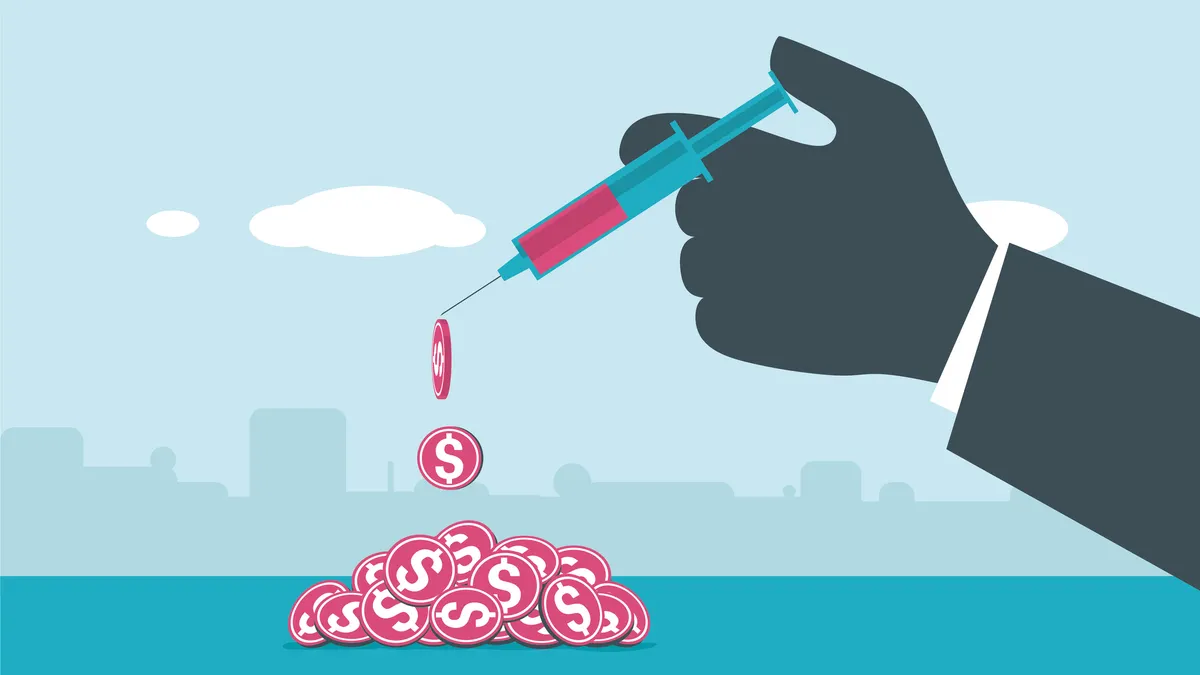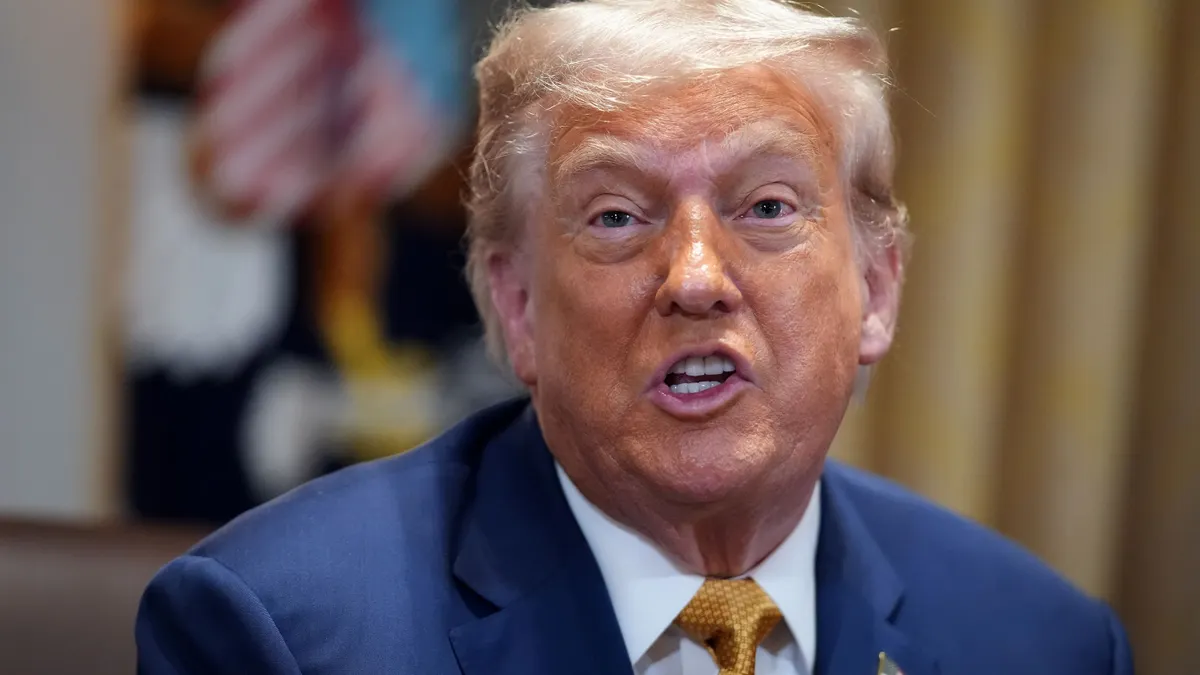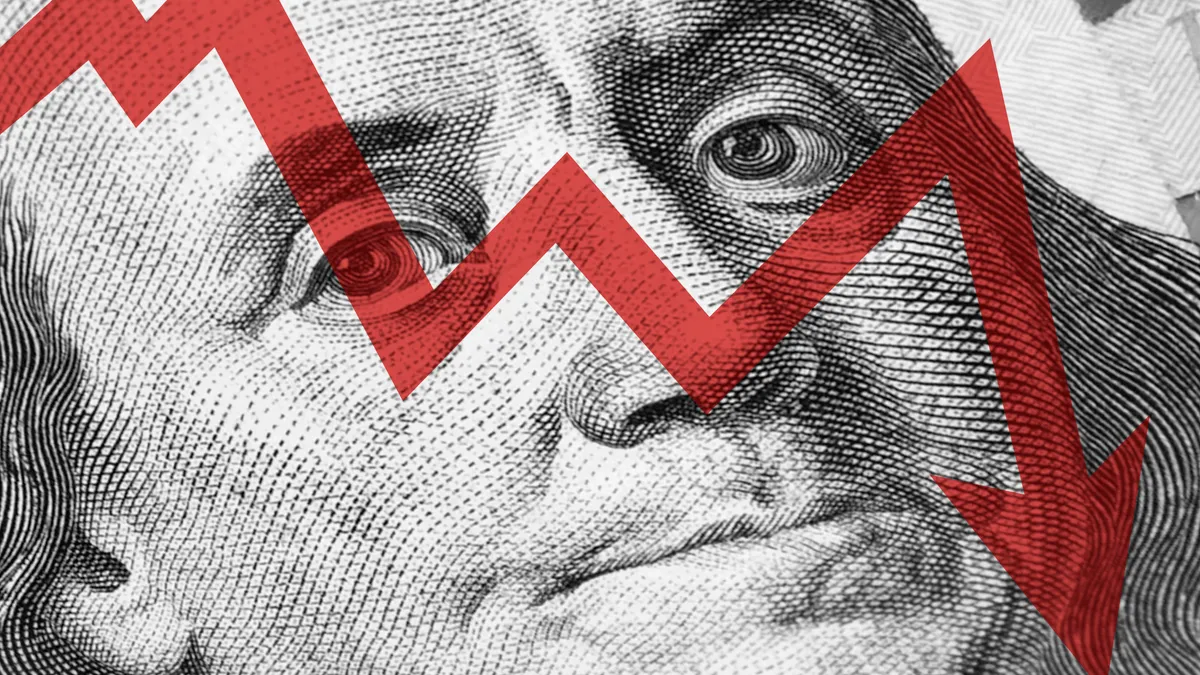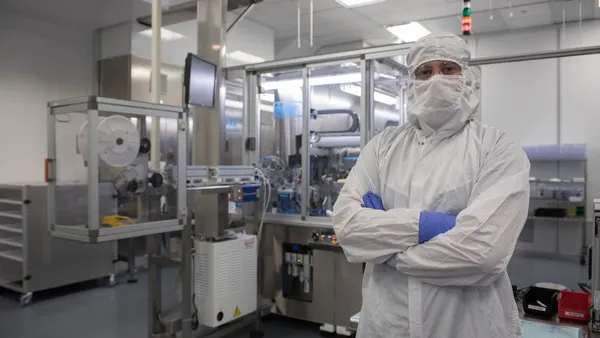 Creative directors don’t just direct creative; they are responsible for the creative vision of an agency; the look, the feel, and the tone of a brand; and for leading and keeping their creative teams at the top of their game. They need to have a strong point of view and vision and they must be able to articulate that vision to not only their clients but to their teams as well.
Creative directors don’t just direct creative; they are responsible for the creative vision of an agency; the look, the feel, and the tone of a brand; and for leading and keeping their creative teams at the top of their game. They need to have a strong point of view and vision and they must be able to articulate that vision to not only their clients but to their teams as well.
Today’s Creative Director
With the infusion of new media channels and a significantly more involved patient population, today’s creative directors must wear more hats than their creative forebears to keep their clients and teams happy.
“The role of the creative director is essentially the same as it has been for years: delivering powerful and effective ideas," says Diane Iler-Smith, executive VP, chief creative officer, Ogilvy Healthworld, part of Ogilvy CommonHealth Worldwide. “It’s the journey to the big idea that has changed. There are more stakeholders involved, more regulatory constraints to navigate, and on a positive note, more channels to explore."
Rick Conrad, creative director at AbelsonTaylor, agrees that the basic role of keeping creative people challenged and inspired hasn’t changed, but what has changed is encouraging creatives to think more holistically and at a higher level.
“It’s important to maintain an environment and provide resources for inspiration, not only with what’s happening in our industry, but also in the creative world," Mr. Conrad says. “Thinking bigger and across multiple channels is mandatory in today’s information-heavy environment. Creating the idea is still the goal, but giving the idea long legs so it can extend into other areas is the real task."
Creative experts agree while the fundamentals are the same, the amount of information and the speed of communications are what has changed.
“As our ability to understand our audience increases, we’re under more pressure to deliver work that moves the needle," says Barclay Missen, VP, chief creative officer, at GA Communication Group. “In some ways it’s no different from how it’s always been; we just have more sophisticated ways to pay attention and bring ideas to life."
It’s no surprise that the rise of digital media and new channels is changing how creative directors have to think on a number of levels.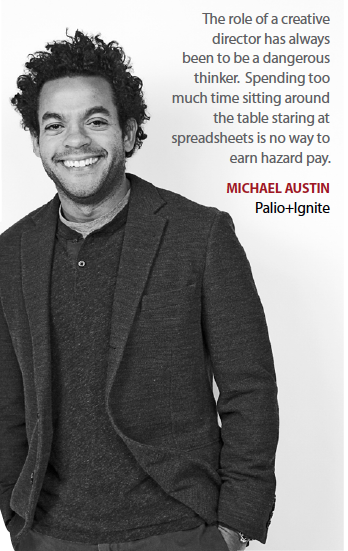
“First, we need to lead the charge in terms of understanding what makes great creative in digital channels versus print because they are not the same thing," says Abby Mansfield, senior VP, creative director, at Topin & Associates. “Second, we need to manage creative departments that are in transition — and trying to create ‘media agnostic’ creative people isn’t easy. Third, we need to get less-than-savvy clients to trust our expertise in the face of ever-changing technology. And finally, and most importantly, we need to focus on creating ideas that are big enough to not just hold a great concept, but great content as well."
Given the proliferation of digital media, the creative team has now grown far beyond the traditional art and copy functions found in most agencies.
“For example, UX practitioners, interface designers, search pros, programmers, and other technologists are now integral parts of agency creative work," says Steve Hamburg, chief creative officer, Calcium. “A modern CD understands what these talented people do, how they can work with the core — art and copy — creative team, and when to bring them into the creative process.
“Today’s creative director also needs to educate these newer team members on the fundamentals of strategy, branding, concepting, copywriting, and design," Mr. Hamburg continues. “The synergy that can be created between technological and ideational skill sets can have a powerful impact both on the work and the work experience. Ultimately, this synergy produces communications that are more likely to enlighten and engage, giving the team a greater potential to activate audiences and transform lives and businesses."
Some creative directors, such as Michael Austin, executive creative director, Palio+Ignite, an inVentiv Health company, acknowledge that the role has grown beyond the work and encompasses aspects beyond the creative.
“There’s the work and then there’s everything else," he says. “I think the everything else has begun to overstep its bounds the last few years. The role of a creative director has always been to be a dangerous thinker. Spending too much time sitting around the table staring at spreadsheets is no way to earn hazard pay."
 Traditionally, the end goal of a creative campaign is to build a brand that has lasting recognition, which is still true today, but with a twist.
Traditionally, the end goal of a creative campaign is to build a brand that has lasting recognition, which is still true today, but with a twist.
“People identify through brands, and today, brands have to have true ongoing brand engagement that needs to stretch beyond the brand campaign and reach customers on a deeper, authentic, and more meaningful level," says Tina Fascetti, chief creative officer at Guidemark Health. “Creative directors need to engage talent across multiple platforms and invite other players into the creative ideation mix to ensure that they are delivering the kind of deeper level engagements to drive behavior change."
At the end of the day, creative directors agree that in certain respects, their role has not changed, and they remain, as Mr. Hamburg says, as the catalyst for bigger and better ideas.
“No matter what the medium or technology, ideas continue to be the lifeblood of our industry," he says. “It remains a primary function of the creative director to fan the flames of inspiration and talent; to kindle awe-inspiring creative fires; and to help generate real and measurable brand heat in the marketplace."
Challenges Beyond the Drawing Board
Time, or rather the lack thereof, is seemingly something that all creative directors must manage through, as well as 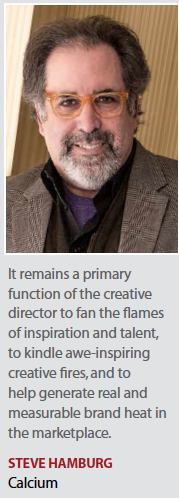 keeping abreast of the ebbs and flows of client demands in terms of personnel.
keeping abreast of the ebbs and flows of client demands in terms of personnel.
In addition to the ever-present and increased vigilance around legal and regulatory issues, Julie Hogrefe, creative director at LeveragePoint Media, says she and her team are challenged with having to adhere to tighter and tighter deadlines.
“More than ever, as a creative director I need to be as proactive as possible, adapt to changing requirements, and be ready to respond when last-minute situations arise," she says. “Also, since our focus is on the pharmacy channel, we also are required to gain approval of retailers, such as chain drug stores. They may have their own set of conditions and opinions about acceptable creative, so this needs to be taken into account as well."
“Making time to do everything that I want to do is a challenge," Mr. Missen says. “Luckily I work in an environment that is supportive and risk-tolerant. There are so many interesting ideas, programs, and directions to pursue it’s easy to get lost in details or overthink big-picture initiatives. To succeed, we have to be able to ride that line between theory and practice, planning and execution, sublime and mundane, etc.; the line is everywhere."
Ms. Iler-Smith agrees that there is less time for ideation.
“With each passing year, timelines for creative development seem to get shorter and shorter," she says. “The wave of breakthrough designations from the FDA and accelerated approvals may be contributing to the shrinking timelines for brand development."
Mr. Conrad agrees that timelines are tighter and clients expect more in a much shorter timeframe, adding that another challenge is finding time to be involved in projects for multiple clients.
“In both of these cases, it helps to have creative people who can take projects and run with them and work quickly, yet still create great work," he says. “If you are a control freak, the job of creative director isn’t for you. Your job is to direct and guide the work, put the right people in place, and then let them do their thing."
Managing internal resources to adjust for shifting timelines, regulatory constraints, and legal review is just one piece of the puzzle that creative directors must oversee. They also have to contend with client issues as well, including brand manager turnover, risk aversion, and the strategic integration of multiple communications channels.
“I find the biggest challenges often stem from one thing — turnover on the client side," Ms. Mansfield says. “It used to be that brand teams were deep in both number and years of experience. Now it seems that product managers have less time on their brand and less mentoring, yet they’re responsible for some very big brand decisions. This just makes our job — trying to get them comfortable with new ideas — more difficult because they don’t have experience to trust us as partners nor experienced supervisors to go to."
Creating memorable connections amid budgetary constraints is even harder.
“While most pharma clients tend to be risk averse, the increasing economic pressures — do more with less budgets — have made them seek the safe, tried-and-true solution even more," Ms. Mansfield says. “Clients feel like they can’t do new things without making sure the basics are covered, and often the basics are all their budgets cover. And out of that comes the realization that service is the biggest expectation clients have today. They want work that is produced on time, on budget, and without hiccups — whether it’s breakthrough or not often seems to be secondary."
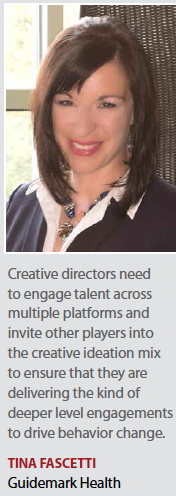 Ms. Fascetti says due to tighter brand budgets, clients also are looking for strategic and creative partners, not agency services.
Ms. Fascetti says due to tighter brand budgets, clients also are looking for strategic and creative partners, not agency services.
“Clients are aware of the ongoing need to engage audiences over time and need to have confidence that their agency has the right subject-matter experts for the right job who can ask them what keeps them up at night, and come up with ideas that move their brands forward," she says. “Creative directors need to give them the confidence that they are capable of solving their biggest marketing problems and ultimately making them highly successful."
Part of this confidence comes from the creative team’s ability to communicate why ideas can work, even if they are not what they had in mind or the vision isn’t exactly how they saw it.
“I think it’s true that some clients don’t get it, but it’s on us to help them get it," Mr. Conrad says. “I understand clients’ aversion to risk. They have to answer to their bosses and prove that the work can yield results. Part of our job as creative leaders is to help them to understand why risk could be beneficial — assuming it’s on strategy — and how it could work for them. I always like to say, ‘let’s give clients what they don’t know they want.’ And sometimes these are risky, unexpected ideas."
Ms. Iler-Smith agrees that more than ever before, clients want creative teams who are engaged in their business and passionate about their brands.
“Clients want partners who care as much if not more about their brands as they do," she says. “Clients appreciate and respect creatives who can clearly articulate the thinking behind their ideas and understand how to deliver big ideas while navigating the approval process."
As with all things in life, clients come in all different sizes and with different ways of thinking. There are some clients who expect their agency partners to understand their business as well as they do, and then there are clients who want agency partners to help expand on their goals and strategies, and there are some clients who want everything tied together.
“Clients expect us to know their business," Mr. Conrad says. “It all starts with knowing who they are, what the brand stands for, and what they want to accomplish. This is where strong strategy comes in. We need to work with clients to create strong positioning so we can develop strong, creative ideas. They expect great creative, everything from solid ideas to the execution of those ideas. Clients want more than just consultants; they want us to be able to push ideas forward beyond traditional channels. I also think clients want a strong relationship with their agency. Personally, I think it makes the working relationship, and the work, better."
Clients want it all, they want it now, or yesterday if possible, and under budget, Mr. Missen says.
“The deliverables have changed but the expectations have not, and I don’t think they should," he adds. “We don’t work with clients that ‘don’t get it.’ If they don’t get it, then it’s our fault for not getting them. We’re here to help them accomplish their goals, not force ideas down their throats. All of our clients know their business better than we do. They live it. We’re here to help them apply their knowledge in constructive ways that the audience remembers and reacts to."
Mr. Hamburg says one of the biggest changes he’s seen in recent years is that some clients have become much more savvy about integrated marketing.
“They recognize that everything — online, offline, digital, print, broadcast — works together," he says. “There is a flow of information through this system that creates the desired experience. Savvy clients, in the early stages of planning a campaign, are now as concerned with how this system works as they are about how it looks and sounds. They now rely on us to advise them on how to achieve their brand goals through the interplay and synthesis of the many tools, platforms, and media at our disposal. And, of course, it all has to look and sound great, too."
In Ms. Fascetti’s experience, one of the challenges of being a creative director today is being smart about where and when to release talent.
“We need to ensure that clients are getting the best collective ideas," she says. “It’s not enough to have strong promotional copywriters and art directors as the drivers of the big ideas. A creative leader’s role today must bring a brand to life that delivers habitually true engagements over time that embrace all audiences and connect them in a way that touches them emotionally, yet still changes behaviors."
Translating Brand Insights and Data Into Effective and Integrated Creative
In this age of information saturation, getting an audience’s attention is hard; getting them to act is harder still, Mr. Hamburg says.
“Generating incandescent creative — creative that enlightens, inspires, and lights the way to action — continues to be a core challenge," he says. “It’s tempting to focus on the medium rather than the message, especially given the enormous engagement possibilities opened up by digital media. But it’s vital to remember that audiences consist of individual people, and that individual people still respond to powerful thoughts and feelings that matter to them. In other words, messages are still paramount. As creative directors, we must not lose sight of the notion that powerful words, pictures, and ideas — no matter what channel they’re circulated through — remain magical things that can move hearts and minds."
Mr. Austin warns against muddling the story just because technology allows for more and different types of messaging.
“Technology is a temptress," he says. “We need to beware and not overcomplicate the story just because we can."
Today, audiences want to engage in their health and wellness in more authentic ways and expect to be reached where and when they want to engage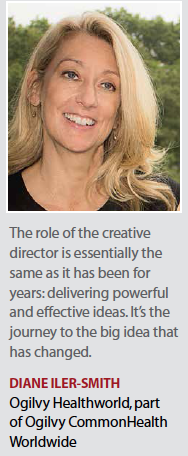 and to understand how they learn.
and to understand how they learn.
“Brand messaging is important but can only take us so far," Ms. Fascetti says. “Knowing the right talent-to-task is key."
Ms. Iler-Smith says one of the biggest challenge is delivering audience-specific messages while ensuring that the brand has “one voice" regardless of channel.
“We develop a communications blueprint for each brand, which provides a clear, consistent go-to-market plan that drives integrated campaign development, including a cohesive and focused messaging platform," she says.
Mr. Conrad’s approach is to keep the positioning statement, key insights, and strategy front and center.
“Every channel we develop has to support the overall message," he says. “No matter where physicians, nurses, patients and consumers find us, the message has to be consistent. It’s doesn’t always have to be said exactly the same way, but it has to ladder up to the overall message."
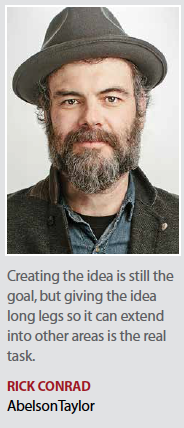 For Mr. Conrad, there is a recipe for creating effective brand messaging, which contributes to the strategy and ideas.
For Mr. Conrad, there is a recipe for creating effective brand messaging, which contributes to the strategy and ideas.
“Insights are extremely important in developing strong creative," he says. “A well-defined insight is as important as a good positioning statement. Research and data are important as well. I do think teams can get handcuffed by data if it’s the only thing driving positioning and ideas, but it can help drive the insight if used correctly. It all gets put into the blender when we’re developing concepts."
To get the most effective creative, customer insights need to be the core of the brand brief, the one document that every brand engagement, not just creative concepts, must deliver, according to Ms. Fascetti.
“By identifying the key behavior-changing insight across each audience, we can then ladder-up to the highest level brand promise that speaks to all audiences with one overarching brand voice," she says. “The messaging and ongoing engagement content can then change depending on the audience."
Ms. Mansfield says there are any number of structured thinking tools — mapping, laddering, etc. — that help distill data, market research, and client input into a selling idea, but what it really comes down to is understanding that at the other end of a rep conversation, an ad, or Web content is a person.
“Once we figure out who that person is, we attack the problem with a mantra of singularity, simplicity, and focus to ensure the creative delivers effectively," she says.
“An insight is a relevant truth, nothing more and nothing less," Mr. Austin says. “It’s not a secret that only you’ve managed to uncover. It’s what the customer already knows, be it consciously or not. Why it’s so important is because it’s the filter through which we determine not only what story to tell but how to tell it. And effective creative is simply a well-told story, nothing more and nothing less. But the process, you ask, that’s a secret."
The best, most effective creative begins with a single-minded and inspirational brief, Ms. Iler-Smith says.
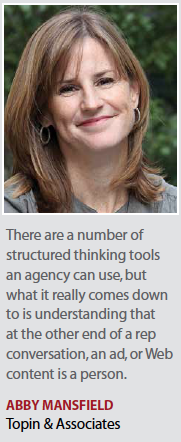 “Ideas flow more freely when the team is focused and moved by the emotionally charged nature of the disease categories," she says. “To fuel additional inspiration, we will often share real patient stories with the creative team and have them meet with real clinicians."
“Ideas flow more freely when the team is focused and moved by the emotionally charged nature of the disease categories," she says. “To fuel additional inspiration, we will often share real patient stories with the creative team and have them meet with real clinicians."
Ms. Hogrefe says her company has developed and continues to update a number of best practices built from the large repository of pharmacy-delivered programs that have been implemented over the years.
“We strive for graphic treatments that will help the design stand out in the pharmacy environment and drive eyes to the message," she says. “It’s important to tailor messages to the needs and motivations of the target audience. They are in the pharmacy; they are thinking about their health. We want to make a connection and can achieve that by directly mentioning a particular condition or calling attention to symptoms. There has to be an element of stopping power and a call to action. This can often be achieved by understanding the questions that might be on the mind of the consumer, and posing those questions prominently in the creative."
Mr. Missen says he starts by asking lots of smart people lots of questions, and the harder the questions are the better.
“We rely on using a brief as the backbone to help guide us to the right insights," he explains. “Ideally, we collaborate on writing the brief. This way it becomes a shared document that is used to guide and inspire — not a weapon to CYA or defend a poor execution. The brief begins the ideation. We use minds and pencils for that. The more the merrier. When we have some good ideas, we execute them. We critique and tighten all the way along using the brief and our creative criteria. We know we can stop when we are arguing about which good idea to throw out. If we’re throwing out good ideas, then whatever is left over is going to be great work. One other critical point to make is that we invite and encourage participation from the whole team — account group, producers, digital strategy, creative — whoever happens to be able to contribute. If it’s good, we’ll take it, smart people focusing on the work." (PV)
~~~~~~~~~~~~~~~~~~~~~~~~~~~~~~~~~
Inspiring Leadership
Several of the industry’s top creative experts provide their best practices for keeping their creative teams thinking creatively.
Michael Austin / Palio+Ignite
I give them the freedom to fail. Nothing cripples creativity more than fear.
Rick Conrad / AbelsonTaylor
I provide them with resources and encourage them to look at what’s happening inside our industry and beyond. I am always referencing work from outside of our industry. We can all learn from solid creative work and ideas that exist out in the world. Our group has its own Twitter page that showcases cutting-edge work and industry trends. I encourage my team to reference new work every day. We also have sessions where team members share things they find inspiring: new trends and just plain cool stuff. There are no rules; you find something cool, bring it in and show us.
Tina Fascetti / Guidemark Health
I believe in the old tried-and-true saying, roots and wings. The most important things I can do to keep the team inspired are to coach, praise, and then remove obstacles and present an environment that makes it safe for them to feel free to create. I also believe casting the vision for the company, establishing goals, and building an environment where people can stretch, grow, and learn. To do that, I believe in mixing up ideation teams from time to time so they can learn from each other. True creative people are not afraid of change and thrive in an environment that promotes variety.
Steve Hamburg / Calcium
We constantly challenge our teams. Whether it’s working in a new medium, adopting a new voice, or a new style, we make sure they are always learning something new. This encourages our creative staff to reach out to their colleagues to help them solve problems and overcome blocks. Team members learn from each other, and gain new respect for one another. The return on this investment is, they challenge us right back. The best part of my job is being presented with something I just wasn’t expecting, something that’s so much better than what was in my head. It’s humbling and gratifying. And it fires up my own creative engines.
Diane Iler-Smith / Ogilvy Healthworld, part of Ogilvy CommonHealth Worldwide
We are very fortunate to live in the Ogilvy & Mather Chocolate Factory where creativity is celebrated and cultivated. From rooftop concerts featuring upcoming musicians to lectures by guest speakers, inspiration is all around us.
Abby Mansfield / Topin & Associates
Different kinds of inspiration are needed at different times to keep a consistently high level of work. When we’re in a new campaign — or pitch — mode, creatives need the inspiration to see a grain of a new idea through, so I try to focus on what’s right about an idea and push them to flesh it out, develop it, and test it as far as they can. But when we’re in a campaign maintenance mode, the creative challenge is different; the challenge is to keep ideas and people fresh when the team has done 32 sales aids within the same campaign already. This is when I try to point out that no matter how routine the tactic may be, for example, a physician wall poster, there’s always something that can be different or new or engaging.
Barclay Missen / GA Communication Group
All the people I work with have diverse interests and passions and are intrinsically motivated. On top of being really creative and talented, the people I work with are control-freak perfectionists, who are incredibly responsible and committed to what they do. My biggest concern is getting enough people to help out so that no one burns out. It’s hard. I try to make sure they are not killing themselves and encourage them to pursue other interests and live a rich life. It’s win-win-win that way. I believe the core of creativity is random association. To be able to create, you need raw materials, in this case — random stuff — to be able to associate. We don’t get that from grinding out another banner ad at 11:30 on a Monday night. We get creative when the mind is relaxed and our head is full of experiences that can come together unprompted at the most inopportune times. Find good people and get out of their way. That’s the secret.
~~~~~~~~~~~~~~~~~~~~~~~~~~~~~~~~~
Thought leader quotes:
The role of a creative director has always been to be a dangerous thinker. Spending too much time sitting around the table staring at spreadsheets is no way to earn hazard pay.
Michael Austin / Palio+Ignite
More than ever, as a creative director I need to be as proactive as possible, adapt to changing requirements, and be ready to respond when last-minute situations arise.
Julie Hogrefe / LeveragePoint Media
It remains a primary function of the creative director to fan the flames of inspiration and talent, to kindle awe-inspiring creative fires, and to help generate real and measurable brand heat in the marketplace.
Steve Hamburg / Calcium
Creative directors need to engage talent across multiple platforms and invite other players into the creative ideation mix to ensure that they are delivering the kind of deeper level engagements to drive behavior change.
Tina Fascetti / Guidemark Health
The role of the creative director is essentially the same as it has been for years: delivering powerful and effective ideas. It’s the journey to the big idea that has changed.
Diane Iler-Smith / Ogilvy Healthworld, part of Ogilvy CommonHealth Worldwide
Creating the idea is still the goal, but giving the idea long legs so it can extend into other areas is the real task.
Rick Conrad / AbelsonTaylor
There are a number of structured thinking tools an agency can use, but what it really comes down to is understanding that at the other end of a rep conversation, an ad, or Web content is a person.
Abby Mansfield / Topin & Associates
~~~~~~~~~~~~~~~~~~~~~~~~~~~~~~~~~
~~~~~~~~~~~~~~~~~~~~~~~~~~~~~~~~~
Thought leader quotes:
The role of a creative director has always been to be a dangerous thinker. Spending too much time sitting around the table staring at spreadsheets is no way to earn hazard pay.
Michael Austin / Palio+Ignite
More than ever, as a creative director I need to be as proactive as possible, adapt to changing requirements, and be ready to respond when last-minute situations arise.
Julie Hogrefe / LeveragePoint Media
It remains a primary function of the creative director to fan the flames of inspiration and talent, to kindle awe-inspiring creative fires, and to help generate real and measurable brand heat in the marketplace.
Steve Hamburg / Calcium
Creative directors need to engage talent across multiple platforms and invite other players into the creative ideation mix to ensure that they are delivering the kind of deeper level engagements to drive behavior change.
Tina Fascetti / Guidemark Health
The role of the creative director is essentially the same as it has been for years: delivering powerful and effective ideas. It’s the journey to the big idea that has changed.
Diane Iler-Smith / Ogilvy Healthworld, part of Ogilvy CommonHealth Worldwide
Creating the idea is still the goal, but giving the idea long legs so it can extend into other areas is the real task.
Rick Conrad / AbelsonTaylor
There are a number of structured thinking tools an agency can use, but what it really comes down to is understanding that at the other end of a rep conversation, an ad, or Web content is a person.
Abby Mansfield / Topin & Associates
~~~~~~~~~~~~~~~~~~~~~~~~~~~~~~~~~





